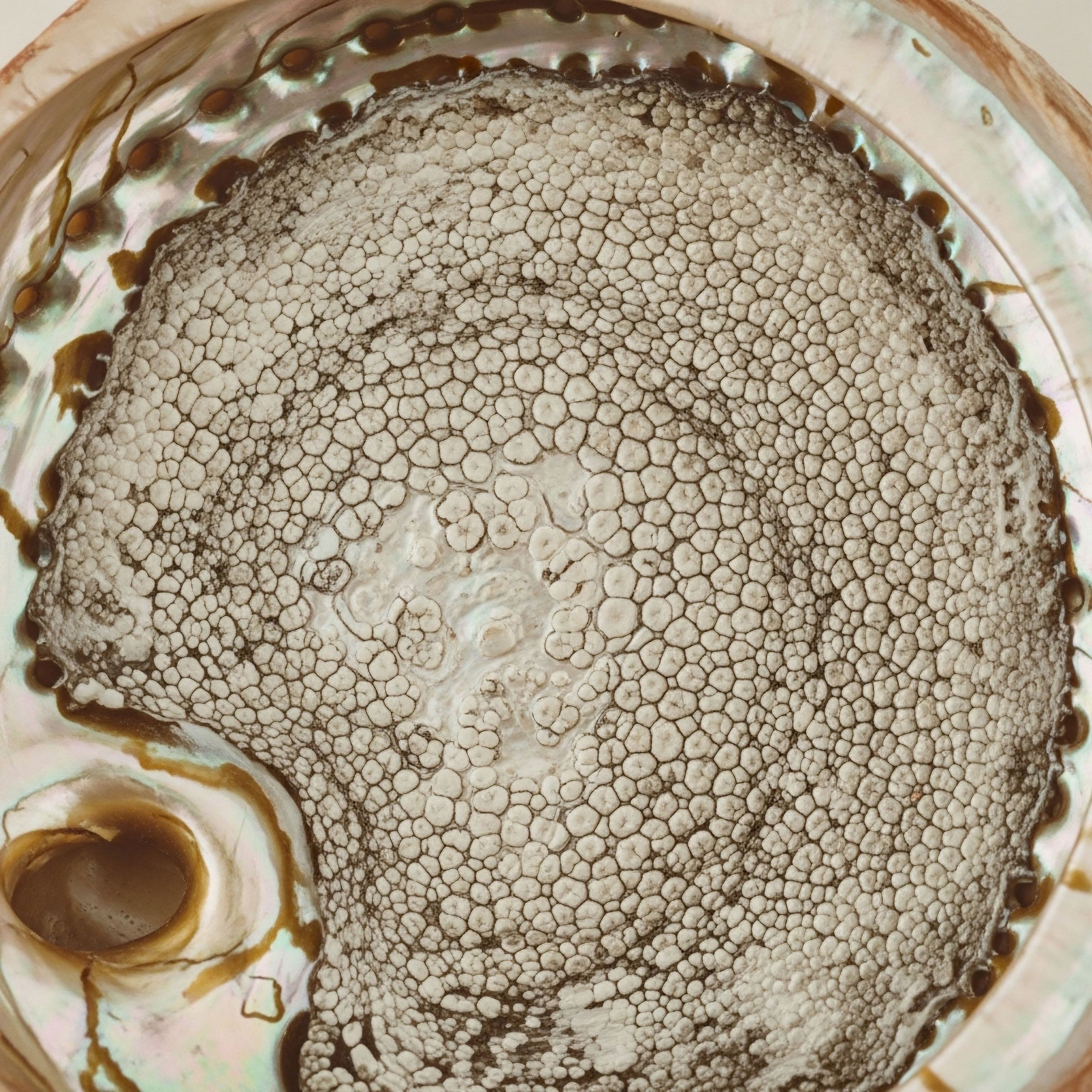

Fundamentals
Have you ever experienced a subtle, yet persistent, shift in your overall well-being? Perhaps a lingering sense of fatigue that sleep cannot fully resolve, or a diminished capacity for physical activity that once felt effortless. Many individuals report a gradual decline in their vitality, a quiet erosion of the energy and mental clarity that once defined their daily existence.
This experience is often accompanied by a sense of frustration, as conventional explanations may not fully account for these changes. The body’s intricate internal communication networks, particularly the endocrine system, frequently play a central role in these subjective shifts. When these systems operate optimally, a sense of robust health and energetic equilibrium prevails. When imbalances arise, however, the impact can ripple across various physiological domains, influencing everything from mood regulation to physical endurance.
Understanding these internal biological systems offers a pathway to reclaiming a sense of vibrant function. The human body operates as a highly interconnected system, where no single component acts in isolation. Hormones, for instance, serve as vital chemical messengers, orchestrating a vast array of physiological processes.
They regulate metabolism, influence mood, govern reproductive functions, and play a significant part in maintaining tissue integrity. When the delicate balance of these messengers is disrupted, the consequences can manifest as a spectrum of symptoms, ranging from subtle alterations in sleep patterns to more pronounced changes in body composition or cognitive sharpness. Recognizing these connections marks the initial step toward addressing the root causes of diminished well-being.
The body’s internal communication networks, especially the endocrine system, profoundly influence daily vitality and overall well-being.

The Endocrine System an Overview
The endocrine system comprises a collection of glands that produce and secrete hormones directly into the bloodstream. These chemical signals then travel to target cells and organs throughout the body, initiating specific responses. Consider the hypothalamic-pituitary-gonadal (HPG) axis, a prime example of such a regulatory loop.
The hypothalamus, a region in the brain, releases gonadotropin-releasing hormone (GnRH), which prompts the pituitary gland to secrete luteinizing hormone (LH) and follicle-stimulating hormone (FSH). These gonadotropins, in turn, stimulate the gonads ∞ testes in men and ovaries in women ∞ to produce sex hormones like testosterone and estrogen.
This intricate feedback mechanism ensures that hormone levels remain within a tightly controlled physiological range. Disruptions at any point along this axis can lead to widespread systemic effects, affecting energy, mood, and physical capacity.
Beyond the HPG axis, other endocrine glands, such as the thyroid, adrenal glands, and pancreas, contribute to the body’s metabolic and adaptive capabilities. The thyroid gland, for instance, produces hormones that regulate metabolic rate, influencing energy production and body temperature. The adrenal glands secrete cortisol, a hormone critical for stress response and inflammation modulation.
The pancreas produces insulin and glucagon, which manage blood glucose levels. Each of these components contributes to a complex web of interactions, where the function of one gland can directly influence the activity of others. A holistic perspective on health necessitates appreciating these interconnected relationships.

Hormonal Balance and Daily Function
Maintaining hormonal equilibrium is fundamental for sustained physical and mental performance. When hormone levels deviate from their optimal ranges, individuals often report a decline in their overall quality of life. For men, a reduction in testosterone levels, commonly associated with aging, can lead to symptoms such as reduced muscle mass, increased body fat, diminished libido, and a general lack of drive.
This condition, often termed andropause or late-onset hypogonadism, reflects a physiological shift that can significantly impact daily function and emotional well-being. Addressing these changes involves a careful assessment of individual hormonal profiles and a tailored approach to restoration.
For women, hormonal fluctuations are a natural part of life, particularly during stages like perimenopause and post-menopause. These transitions can bring about a variety of symptoms, including irregular menstrual cycles, hot flashes, sleep disturbances, mood swings, and changes in sexual function.
The decline in estrogen and progesterone production from the ovaries plays a central role in these experiences. Understanding the specific hormonal shifts occurring within an individual’s system allows for the development of personalized strategies aimed at alleviating discomfort and restoring a sense of balance. The goal is always to support the body’s inherent capacity for equilibrium, allowing individuals to navigate these life stages with greater ease and vitality.

Can Peptide Therapies Be Integrated with Existing Wellness Programs for Enhanced Outcomes?
The question of whether peptide therapies can be integrated with existing wellness programs for enhanced outcomes is a pertinent one for those seeking to optimize their health. Peptide therapies represent a sophisticated approach to modulating biological function, utilizing short chains of amino acids that act as signaling molecules within the body.
These molecules can mimic or influence the action of naturally occurring hormones, growth factors, or neurotransmitters, offering a targeted means of addressing specific physiological needs. Their precise mechanisms of action often involve interacting with specific receptors to initiate or inhibit cellular processes, thereby influencing a wide array of bodily functions.
Existing wellness programs typically encompass a range of interventions, including nutritional guidance, exercise regimens, stress management techniques, and sometimes foundational supplementation. These programs aim to support overall health by optimizing lifestyle factors. The integration of peptide therapies introduces a powerful layer of biological modulation, potentially accelerating or augmenting the positive effects of these established wellness practices.
For instance, if a wellness program focuses on improving body composition through diet and exercise, certain peptides could be introduced to support muscle protein synthesis or fat metabolism, thereby enhancing the program’s efficacy. This synergistic approach recognizes the body’s complex regulatory systems and seeks to provide targeted support where natural processes may be suboptimal.
The potential for synergy arises from the fact that peptides can address specific biochemical pathways that might be resistant to lifestyle interventions alone. For example, while exercise stimulates growth hormone release, certain growth hormone-releasing peptides can provide a more consistent and potent stimulus, leading to more pronounced effects on tissue repair and metabolic function.
This complementary relationship allows for a more comprehensive strategy, moving beyond general health support to precise biological recalibration. The objective is not to replace foundational wellness practices, but to augment them, providing a more direct and efficient route to achieving desired physiological states and overall well-being.


Intermediate
Understanding the precise mechanisms and applications of various therapeutic agents becomes paramount when considering the integration of peptide therapies into established wellness protocols. These agents are not broad-spectrum remedies; rather, they are highly specific signaling molecules designed to interact with particular receptors or pathways within the body.
The goal is to restore physiological balance and enhance systemic function by providing targeted biochemical support. This section details several key protocols, explaining their scientific rationale and how they might complement an individual’s broader health strategy.

Testosterone Replacement Therapy Men
For men experiencing symptoms associated with declining testosterone levels, often referred to as late-onset hypogonadism, Testosterone Replacement Therapy (TRT) represents a well-established intervention. The standard protocol frequently involves weekly intramuscular injections of Testosterone Cypionate, typically at a concentration of 200mg/ml.
This exogenous testosterone aims to restore circulating levels to a physiological range, alleviating symptoms such as reduced energy, decreased muscle mass, increased adiposity, and diminished libido. The rationale behind this approach centers on replenishing a vital hormone that plays a central role in male physiology, influencing everything from bone density to cognitive function.
To mitigate potential side effects and preserve endogenous testicular function, TRT protocols often incorporate additional medications. Gonadorelin, administered via subcutaneous injections twice weekly, is a synthetic analog of GnRH. Its purpose is to stimulate the pituitary gland to release LH and FSH, thereby maintaining natural testosterone production within the testes and preserving fertility.
This approach helps to counteract the suppressive effect of exogenous testosterone on the HPG axis. Furthermore, Anastrozole, an aromatase inhibitor, is often prescribed as an oral tablet twice weekly. Its role is to block the conversion of testosterone into estrogen, preventing estrogenic side effects such as gynecomastia or fluid retention, which can occur when testosterone levels are elevated.
In some cases, Enclomiphene may be included to further support LH and FSH levels, particularly when fertility preservation is a primary concern. This comprehensive approach to male hormonal optimization seeks to restore symptomatic relief while minimizing adverse effects.
Male testosterone optimization protocols often combine exogenous testosterone with agents like Gonadorelin and Anastrozole to manage side effects and preserve natural function.

Testosterone Replacement Therapy Women
Hormonal balance is equally critical for women, and targeted testosterone therapy can address specific symptoms experienced during pre-menopausal, peri-menopausal, and post-menopausal stages. Women may experience symptoms such as irregular cycles, mood changes, hot flashes, and reduced libido, which can be linked to fluctuating or declining hormone levels. While testosterone is often considered a male hormone, it plays a significant role in female physiology, influencing energy, mood, and sexual function.
Protocols for women typically involve much lower doses of testosterone compared to men. Testosterone Cypionate is often administered weekly via subcutaneous injection, with typical doses ranging from 10 ∞ 20 units (0.1 ∞ 0.2ml). This precise dosing aims to restore testosterone to optimal physiological levels without inducing virilizing side effects.
Progesterone is also a key component, prescribed based on the individual’s menopausal status. For pre-menopausal and peri-menopausal women, progesterone supports menstrual cycle regularity and helps balance estrogen, while for post-menopausal women, it is often included as part of a comprehensive hormonal regimen to protect the uterine lining if estrogen is also being administered.
An alternative delivery method, Pellet Therapy, involves the subcutaneous insertion of long-acting testosterone pellets, offering sustained release over several months. Anastrozole may be used in specific cases where estrogen conversion is a concern, although this is less common in female testosterone therapy given the lower dosages. These tailored approaches aim to alleviate symptoms and restore a sense of well-being throughout various life stages.

Post-TRT or Fertility-Stimulating Protocol Men
For men who have discontinued TRT or are actively trying to conceive, a specific protocol is implemented to stimulate the body’s natural testosterone production and support fertility. The exogenous testosterone administered during TRT suppresses the HPG axis, leading to reduced endogenous testosterone synthesis and often impaired spermatogenesis. The goal of this protocol is to reactivate the body’s intrinsic hormonal pathways.
This protocol typically includes a combination of agents designed to stimulate the pituitary and testes. Gonadorelin is utilized to pulse the pituitary, encouraging the release of LH and FSH, which in turn stimulate testicular function. Tamoxifen and Clomid (clomiphene citrate) are selective estrogen receptor modulators (SERMs) that block estrogen’s negative feedback on the hypothalamus and pituitary.
By blocking these receptors, they signal the brain to produce more GnRH, LH, and FSH, thereby stimulating endogenous testosterone production and spermatogenesis. Anastrozole may be optionally included to manage estrogen levels, particularly if there is a concern about elevated estrogen during the recovery phase, which could otherwise inhibit the HPG axis. This multi-agent strategy provides comprehensive support for restoring natural hormonal function and reproductive capacity.

Growth Hormone Peptide Therapy
Growth hormone peptide therapy offers a targeted approach for active adults and athletes seeking benefits such as anti-aging effects, muscle gain, fat loss, and improved sleep quality. These peptides work by stimulating the body’s natural production and release of growth hormone (GH) from the pituitary gland, rather than introducing exogenous GH directly. This approach aims to mimic the body’s physiological pulsatile release of GH, potentially leading to a more favorable safety profile.
Key peptides utilized in this context include:
- Sermorelin ∞ A growth hormone-releasing hormone (GHRH) analog that stimulates the pituitary to release GH. It has a relatively short half-life, promoting a more natural, pulsatile release.
- Ipamorelin / CJC-1295 ∞ Ipamorelin is a growth hormone secretagogue (GHS) that selectively stimulates GH release without significantly affecting cortisol or prolactin levels.
CJC-1295 is a GHRH analog with a longer half-life, providing a sustained stimulus for GH release. Often, CJC-12995 is combined with Ipamorelin to achieve both sustained and pulsatile GH release.
- Tesamorelin ∞ A GHRH analog specifically approved for reducing visceral adipose tissue in certain conditions, it also promotes GH release and has broader metabolic benefits.
- Hexarelin ∞ Another GHS that stimulates GH release, often noted for its potent effects on appetite and gastric motility, alongside its GH-releasing properties.
- MK-677 (Ibutamoren) ∞ An oral GHS that stimulates GH release by mimicking the action of ghrelin.
It offers the convenience of oral administration and a prolonged effect on GH levels.
These peptides, by enhancing natural GH secretion, can support tissue repair, collagen synthesis, metabolic efficiency, and sleep architecture, contributing to a sense of renewed vitality and physical capacity.

Other Targeted Peptides
Beyond hormonal and growth hormone modulation, other peptides address specific physiological needs, offering precise interventions for various aspects of well-being. These targeted agents demonstrate the versatility of peptide therapeutics in addressing complex biological challenges.
One such peptide is PT-141 (Bremelanotide), which is utilized for sexual health. This synthetic peptide acts on melanocortin receptors in the brain, influencing neural pathways associated with sexual arousal and desire. It is distinct from traditional erectile dysfunction medications, as it addresses the central nervous system components of sexual function, making it effective for both men and women experiencing hypoactive sexual desire disorder. Its mechanism of action bypasses the vascular system, offering a different approach to enhancing sexual response.
Another significant peptide is Pentadeca Arginate (PDA), which is being explored for its role in tissue repair, healing, and inflammation modulation. PDA is a synthetic peptide derived from a naturally occurring protein. Its proposed mechanisms involve supporting cellular regeneration, reducing inflammatory responses, and promoting angiogenesis (the formation of new blood vessels), all of which are critical for effective tissue repair following injury or stress.
Its potential applications span various conditions characterized by tissue damage or chronic inflammation, offering a novel avenue for accelerating recovery and restoring tissue integrity. The specificity of these peptides allows for highly individualized treatment plans, addressing particular symptoms or physiological deficits within a broader wellness framework.
| Peptide Name | Primary Application | Mechanism of Action |
|---|---|---|
| Testosterone Cypionate (Men) | Male hormone optimization, symptom relief for low testosterone | Exogenous hormone replacement, binds to androgen receptors |
| Gonadorelin | Maintain natural testosterone production, fertility preservation | Stimulates pituitary release of LH and FSH |
| Anastrozole | Estrogen conversion blockage, side effect reduction | Aromatase inhibitor, reduces estrogen synthesis |
| Sermorelin | Growth hormone release, anti-aging, muscle gain, fat loss | GHRH analog, stimulates pituitary GH secretion |
| Ipamorelin / CJC-1295 | Enhanced growth hormone release, improved body composition, sleep | Ipamorelin ∞ GHS; CJC-1295 ∞ long-acting GHRH analog |
| PT-141 | Sexual health, libido enhancement | Melanocortin receptor agonist, acts on CNS pathways |
| Pentadeca Arginate (PDA) | Tissue repair, healing, inflammation modulation | Supports cellular regeneration, reduces inflammation |


Academic
The integration of peptide therapies into comprehensive wellness programs necessitates a deep understanding of their molecular mechanisms and their interplay within the complex biological systems of the human body. This academic exploration moves beyond symptomatic relief to consider the intricate feedback loops, cellular signaling pathways, and metabolic cascades that peptides influence.
A systems-biology perspective reveals how these targeted interventions can recalibrate physiological set points, thereby promoting sustained health and vitality. Our focus here centers on the profound interconnectedness of the neuroendocrine axes and their metabolic ramifications, particularly as they relate to growth hormone and gonadal steroid regulation.

The Somatotropic Axis and Metabolic Recalibration
The somatotropic axis, comprising the hypothalamus, pituitary, and liver, orchestrates the production and action of growth hormone (GH) and insulin-like growth factor 1 (IGF-1). The hypothalamus releases growth hormone-releasing hormone (GHRH), which stimulates the anterior pituitary to secrete GH. GH, in turn, acts directly on target tissues and indirectly by stimulating the liver to produce IGF-1.
This axis plays a central role in regulating body composition, bone density, and metabolic homeostasis. Age-related decline in GH secretion, often termed somatopause, contributes to changes such as increased visceral adiposity, reduced lean muscle mass, and diminished bone mineral density.
Peptides like Sermorelin and the Ipamorelin/CJC-1295 combination act as potent modulators of this axis. Sermorelin, a GHRH analog, binds to specific GHRH receptors on somatotrophs in the anterior pituitary, triggering the pulsatile release of endogenous GH. This physiological stimulation contrasts with exogenous GH administration, which can suppress natural GH production and potentially lead to desensitization of GH receptors.
Ipamorelin, a growth hormone secretagogue (GHS), functions by mimicking ghrelin, binding to the GH secretagogue receptor (GHSR-1a) in the pituitary and hypothalamus. This binding stimulates GH release through a distinct pathway, often synergizing with GHRH. When combined with CJC-1295, a long-acting GHRH analog, a sustained elevation of GH pulsatility can be achieved, leading to more consistent physiological effects.
The sustained stimulation of the somatotropic axis by these peptides can lead to a cascade of metabolic improvements, including enhanced lipolysis, increased protein synthesis, and improved glucose utilization, thereby contributing to a more favorable metabolic profile.
Peptides like Sermorelin and Ipamorelin/CJC-1295 modulate the somatotropic axis, promoting physiological growth hormone release for metabolic and body composition benefits.

Gonadal Steroids and Neurotransmitter Function
The influence of gonadal steroids extends far beyond reproductive function, profoundly impacting central nervous system activity and neurotransmitter balance. Testosterone and estrogen, for instance, are neurosteroids, meaning they are synthesized in the brain and exert direct effects on neuronal excitability, synaptic plasticity, and neurotransmitter synthesis and degradation.
For example, testosterone influences dopaminergic and serotonergic pathways, which are critical for mood regulation, motivation, and cognitive processing. Declining testosterone levels in men can correlate with symptoms of reduced drive, low mood, and cognitive fog, reflecting these neurochemical alterations.
Similarly, estrogen plays a vital role in modulating serotonin, norepinephrine, and dopamine systems in the female brain. Fluctuations in estrogen during perimenopause can lead to mood swings, anxiety, and sleep disturbances, directly attributable to its influence on these neurotransmitter systems.
The integration of Testosterone Replacement Therapy (TRT) for men and women, or targeted estrogen/progesterone therapies for women, aims to restore optimal neurosteroid levels. By doing so, these therapies can indirectly recalibrate neurotransmitter function, leading to improvements in mood stability, cognitive clarity, and overall psychological well-being. This demonstrates a sophisticated interplay where systemic hormonal balance directly translates into enhanced neurological function, underscoring the interconnectedness of the endocrine and nervous systems.

Interplay of Endocrine Axes and Metabolic Pathways
The human body’s regulatory systems are not isolated; they operate in a highly integrated fashion. The HPG axis, the somatotropic axis, and the adrenal axis (regulating cortisol) constantly communicate and influence one another. For instance, chronic stress, leading to sustained cortisol elevation from the adrenal glands, can suppress both the HPG axis and the somatotropic axis.
This phenomenon, known as stress-induced hypogonadism or growth hormone resistance, illustrates how one hormonal imbalance can cascade into others, creating a complex web of dysfunction.
Peptide therapies, by targeting specific points within these interconnected axes, offer a means to restore equilibrium. For example, by stimulating endogenous GH release, peptides can improve insulin sensitivity and reduce visceral fat, thereby mitigating metabolic stress that might otherwise negatively impact gonadal function.
Conversely, optimizing gonadal steroid levels through TRT can improve energy metabolism and reduce inflammatory markers, creating a more favorable environment for overall endocrine health. The concept of endocrine crosstalk is central here ∞ interventions in one system can have beneficial ripple effects across others.
This holistic perspective is critical for designing truly effective wellness protocols that address the root causes of physiological decline rather than merely managing symptoms. The aim is to restore the body’s inherent capacity for self-regulation and optimal function by addressing these systemic interdependencies.
| Endocrine Axis | Key Hormones | Interconnections | Relevant Peptides/Therapies |
|---|---|---|---|
| Hypothalamic-Pituitary-Gonadal (HPG) | GnRH, LH, FSH, Testosterone, Estrogen, Progesterone | Influenced by stress (cortisol), impacts metabolism, mood, bone density. | Testosterone Cypionate, Gonadorelin, Tamoxifen, Clomid, Anastrozole |
| Somatotropic (GH-IGF-1) | GHRH, GH, IGF-1 | Influences metabolism, body composition, tissue repair, can be suppressed by high cortisol. | Sermorelin, Ipamorelin, CJC-1295, Tesamorelin, Hexarelin, MK-677 |
| Hypothalamic-Pituitary-Adrenal (HPA) | CRH, ACTH, Cortisol | Impacts HPG and Somatotropic axes, influences stress response, inflammation, metabolism. | (Indirectly influenced by improved HPG/GH function) |
The scientific literature increasingly supports the targeted application of peptides to modulate these complex systems. Clinical trials investigating peptides like Tesamorelin have demonstrated significant reductions in visceral adipose tissue, directly linking somatotropic axis modulation to improved metabolic health.
Research into PT-141 highlights its unique central mechanism of action on melanocortin receptors, offering a distinct pathway for addressing sexual dysfunction that differs from peripheral vascular interventions. The ongoing exploration of peptides like Pentadeca Arginate (PDA) for tissue regeneration and anti-inflammatory effects further underscores the expanding utility of these biomolecules in clinical practice.
These advancements provide a robust scientific foundation for integrating peptide therapies into personalized wellness strategies, offering precise tools to support the body’s intrinsic capacity for repair, regeneration, and optimal function. The precision offered by these molecules allows for a highly individualized approach, moving beyond general supplementation to targeted biochemical recalibration, ultimately supporting an individual’s journey toward reclaiming full vitality.

References
- Vance, Mary L. and Michael O. Thorner. “Growth Hormone-Releasing Hormone.” In De Groot, Leslie J. et al. (Eds.), Endocrinology. W.B. Saunders, 2001.
- Boron, Walter F. and Emile L. Boulpaep. Medical Physiology. Elsevier, 2017.
- Guyton, Arthur C. and John E. Hall. Textbook of Medical Physiology. Elsevier, 2020.
- Swerdloff, Ronald S. and Christina Wang. “Testosterone Replacement Therapy in Men.” New England Journal of Medicine, vol. 383, no. 13, 2020, pp. 1252-1261.
- Davis, Susan R. et al. “Global Consensus Position Statement on the Use of Testosterone Therapy for Women.” Journal of Clinical Endocrinology & Metabolism, vol. 104, no. 10, 2019, pp. 4660-4666.
- Miller, David D. et al. “Bremelanotide for Hypoactive Sexual Desire Disorder in Women ∞ A Randomized Trial.” Obstetrics & Gynecology, vol. 132, no. 4, 2018, pp. 917-925.
- Nieschlag, Eberhard, and Hermann M. Behre. Andrology ∞ Male Reproductive Health and Dysfunction. Springer, 2010.
- Molitch, Mark E. “Growth Hormone Secretagogues.” Clinical Endocrinology, vol. 69, no. 3, 2008, pp. 363-364.
- Clemmons, David R. “Growth Hormone and IGF-I Physiology and Pathophysiology.” Endocrinology and Metabolism Clinics of North America, vol. 36, no. 1, 2007, pp. 1-19.
- Genazzani, Andrea R. et al. “Neuroendocrine Effects of Growth Hormone-Releasing Peptides.” Journal of Endocrinological Investigation, vol. 23, no. 10, 2000, pp. 691-699.

Reflection
As you consider the intricate biological systems that govern your vitality, pause to reflect on your own personal health journey. The information presented here serves as a guide, a map to understanding the complex terrain of hormonal health and metabolic function.
Your unique biological blueprint dictates a path that is distinctly yours, and true well-being arises from a personalized approach. This knowledge empowers you to engage in a more informed dialogue with healthcare professionals, advocating for strategies that align with your individual physiological needs. The journey toward reclaiming optimal function is a collaborative one, rooted in a deep appreciation for your body’s inherent wisdom and its capacity for restoration.



